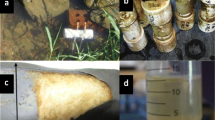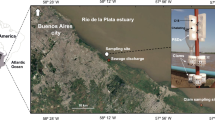Abstract
The ability to sample in situ natural environmental processes has proven to be challenging when working with redox-sensitive contaminates in saturated sediments in wetland systems, especially within the rhizosphere, where sharp redox gradients are common. Many traditional approaches are invasive and disturb natural sediment chemistry. Through laboratory and field studies, the work presented in this study demonstrates a novel semipermanent dialysis sampler that allows for long-term, anaerobic monitoring of shallow sediments. Dialysis samplers were deployed and tested for over 1 year while being exposed to extremes in climate. These newly designed devices produce statistically reproducible data and capture sensitive redox trends. Results from the newly designed samplers were compared to conventional samplers. Initially, both the new and old designs yielded statistically similar data, but these data diverged over a period of months. The new devices are less invasive, so data gathered from these devices are more likely to be a closer representation of true conditions in the subsurface. By giving reliable data from a consistent location in space, these new samplers represent a significant step forward in capturing spatial and temporal variability in wetland redox chemistry during long-term monitoring.





Similar content being viewed by others
References
Carignan, R. (1984). Interstitial water sampling by dialysis—methodological notes. Limnology and Oceanography, 29(3), 667–670.
Carignan, R., & St-Pierre, R. (1994). Use of diffusion samplers in oligotrophic lake sediments: effects of free oxygen in sampler material. Limnology and Oceanography, 39(2), 468–474.
Choi, J. H., Park, S. S., & Jaffe, P. R. (2006). The effect of emergent macrophytes on the dynamics of sulfur species and trace metals in wetland sediments. Environmental Pollution, 140, 286–293.
Cooke, J. C., & Lefor, M. W. (1998). The mycorrhizal status of selected plant species from Connecticut wetlands and transition zones. Restoration Ecology, 6, 213–222.
Doig, L., & Liber, K. (2000). Dialysis minipeeper for measuring pore-water metal concentrations in laboratory sediment toxicity and bioavailability tests. Environmental Toxicology and Chemistry, 19(12), 2882–2889.
Eary, L. E., & Rai, D. (1991). Chromate reduction by subsurface soils under acidic conditions. Soil Science Society of America Journal, 55(3), 676–683.
Franz, T. E., Nolan, J., Nordbotten, J. M., Caylor, K. K., & Slater, L. D. (2011). Quantifying transient soil moisture dynamics using multipoint direct-current resistivity in homogeneous sand. Vados Zone Journal, 10(1), 286–298.
Harper, M. P., Davison, W., & Tych, W. (1997). Temporal, spatial, and resolution constraints for in situ sampling devices using diffusional equilibration: dialysis and DET. Environmental Science & Technology, 31(11)), 3110–3119.
Harter, T., & Talozi, S. A. (2004). Evaluation of a simple, inexpensive dialysis sampler for small diameter monitoring wells. Journal of Groundwater Monitoring and Remediation, 24(4), 97–105.
Hesslein, R. H. (1976). An in situ sampler for close interval pore water studies. Limnology and Oceanography, 21, 912–914.
Jackson, W., Martino, L., Hirsh, S., Wrobel, J., & Pardue, J. (2005). Application of a dialysis sampler to monitor phytoremediation processes. Environmental Monitoring and Assessment, 107, 155–171.
James, B. R. (2001). Remediation-by-reduction strategies for chromate- contaminated soils. Environmental Geochemistry and Health, 23(3), 175–179.
Li, X., & Gallagher, J. L. (1996). Tissue culture and plant regeneration of big cordgrass, Spartina cynosuroides: implications for wetland restoration. Wetlands, 16(4), pp. 410–415.
Lorah, M. M., & Olsen, L. D. (1998). Degradation of 1,1,2,2-tetrachloroethane in a freshwater tidal wetland: field and laboratory evidence. Environmental Science Technology, 33, 227–234.
MacDonald, L. H., Moon, H. S., & Jaffé, P. R. (2011). The role of biomass, electron shuttles, and ferrous iron in the kinetics of Geobacter sulfurreducens-mediated ferrihydrite reduction. Water Research, 45(3), 1049–1062.
McCarthy, K. (2006). Assessment of the usefulness of semipermeable membrane devices for long-term watershed monitoring in an urban slough system. Environmental Monitoring and Assessment, 159, 51–62.
Mohlenbrock, R. H., & Nelson, P. W. (1999). Sedges: Carex (p. 288). Illinois: Southern Illinois University.
Morel, M. M. F., & Hering, J. G. (1993). Principles and applications of aquatic chemistry. New York: Wiley.
Muthukumar, B., Arockiasamy, D., & Natarajan, E. (2004). Direct organogenesis in Datura metal L. from in vivo nodal explants. Indian Journal of Biotechnology, 3, 449–451.
Robertson, E. L., & Liber, K. (2008). Effect of sampling method on contaminant measurement in pore-water and surface water at two uranium operations: can method affect conclusions? Environmental Monitoring and Assessment, 155, 539–553.
Ronen, D., Magaritz, M., & Levy, I. (1987). An in situ multilevel sampler for preventive monitoring and study of hydrochemical profiles in aquifers. Ground Water Monitoring and Remediation, 7(4), 69–74.
Sakaki, T., & Illangasekare, T. H. (2007). Comparison of height-averaged and point-measured capillary pressure–saturation relations for sands using a modified Tempe cell. Water Resources Research, 43, W12502. doi:10.1029/2006WR005814.
Stookey, L. L. (1970). Ferrozine - a new spectrophotometric reagent for iron. Analytical Chemistry, 42, 779–781.
Webster, I. T., Teasdale, P. R., & Grigg, N. J. (1998). Theoretical and experimental analysis of peeper equilibration dynamics. Environmental Science Technology, 32, 1727–1733.
Xu, S., & Jaffe, P. R. (2006). Effects of plants on the removal of hexavalent chromium in wetland sediments. Journal of Environmental Quality, 35, 334–341.
Zazo, J. A., Paull, J. S., & Jaffe, P. R. (2008). Influence of plants on the reduction of hexavalent chromium in wetland sediments. Environmental Pollution, 156, 28–35.
Acknowledgments
Funding for this research was provided by DuPont Corporation and the NJ Meadowlands Commission. MacDonald was supported by EPA-STAR Graduate Research Fellowship F5A20133. The authors would like to thank Joe Vocoturo for assistance with sampler body CAD drawings and the Princeton School of Engineering and Applied Sciences for manufacturing.
Author information
Authors and Affiliations
Corresponding author
Additional information
MacDonald and Paull contributed equally to this manuscript.
Rights and permissions
About this article
Cite this article
MacDonald, L.H., Paull, J.S. & Jaffé, P.R. Enhanced semipermanent dialysis samplers for long-term environmental monitoring in saturated sediments. Environ Monit Assess 185, 3613–3624 (2013). https://doi.org/10.1007/s10661-012-2813-8
Received:
Accepted:
Published:
Issue Date:
DOI: https://doi.org/10.1007/s10661-012-2813-8




